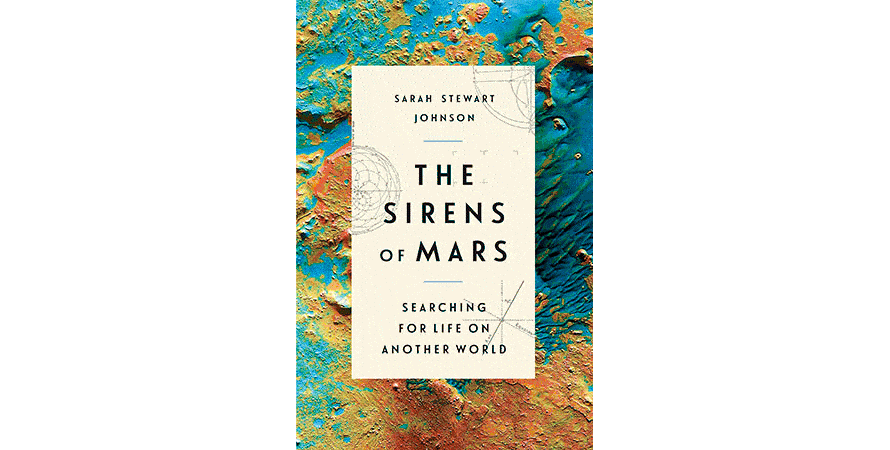Category: Non-Fiction
Reviewed by: Casey Suire
Title: The Sirens of Mars: Searching for Life on Another World
Author: Sarah Stewart Johnson
NSS Amazon link for this book
Format: Hardcover/Kindle
Pages: 288
Publisher: Crown
Date: July 2020
Retail price: $28.99/$14.99
ISBN: 978-1101904817
At the time of this writing, there is not one, not even two, but three spacecraft traveling to Mars! In order of launch date, the three are: Hope (United Arab Emirates), Tianwen 1 (China), and Perseverance (United States). The trio of spacecraft are just the latest examples of humanity’s long fascination with the Red Planet. In The Sirens of Mars: Searching for Life on Another World, the history behind the search for life on Mars is examined. Considering the current emphasis on Martian exploration, it is not a bad idea to read this book.
The contributions of many notable individuals and spacecraft associated with the study of Mars are discussed. Early on, readers are introduced to Italian astronomer Giovanni Schiaparelli. Using a telescope, Schiaparelli named many of the planet’s surface features. He also noticed several channels, believed to be waterways, carved in the Martian landscape. Schiaparelli’s “canali,” Italian for channels, became mistranslated as canals—implying that an intelligent civilization existed on Mars. This idea, famously championed by Percival Lowell, was disproved by the time spacecraft began flying to Mars in the 1960’s.
Nonetheless, the idea of Martian life persisted. In the 1970’s, NASA’s Viking landers performed several life detection experiments on the Red Planet. Here, the book explores the work of many important scientists such as Wolf Vishniac, Norman Horowitz, Vance Oyama, and especially Carl Sagan. Sagan’s unconventional arguments about Martian life are mentioned. Why can’t there be “silicon-based giraffes” roaming around on Mars! Ultimately, Viking did not discover any life. Later on, the book recounts the interesting events surrounding Martian meteorite ALH84001.
The book does a great job describing various unmanned Mars missions. Readers will learn about early attempts such as the disappointing Mariner 4 and the successful Mariner 9. After the Viking missions, there was a long period where no spacecraft visited the Red Planet. From the 1990’s to the present day, however, there has been a resurgence in robotic Martian exploration. The planet has been visited by many orbiters, landers, rovers, and soon, even helicopters.
As previously mentioned, Perseverance is NASA’s current Mars mission. The Perseverance mission is described in the book, although not by name. Perhaps the manuscript was completed before the mission received a name? In any case, Perseverance will carry a tiny craft called Ingenuity—the first helicopter on Mars! Perseverance will also collect samples of Martian rock and soil. A later unmanned Mars mission will transport these samples to Earth for study. In the coming years, it certainly will be interesting to see what discoveries Perseverance will make.
Perhaps the greatest asset of The Sirens of Mars is the author. Sarah Stewart Johnson has a Ph.D. in planetary science from the Massachusetts Institute of Technology and teaches this subject at Georgetown University. In the book, she describes her experiences working on the Spirit, Opportunity, and Curiosity missions. Her strong background makes The Sirens of Mars stand out among other books dealing with the search for Martian life.
The book is only 288 pages long, but despite the short length the book has enough interesting facts and anecdotes to satisfy both serious Mars enthusiasts and newcomers to the subject. The cover of the book, produced by photos taken by the Mars Odyssey orbiter, was a great choice. The colorful imagery really grabs one’s attention.
One noticeable theme throughout The Sirens of Mars is the resiliency of the search for life on Mars. The pages of this book are filled with many twists, turns, and false hopes. Despite this, recent discoveries by numerous spacecraft have kept the quest for life intact.
Is there life on Mars? The search continues.
© 2020 Casey Suire
Please use the NSS Amazon Link for all your book and other purchases. It helps NSS and does not cost you a cent! Bookmark this link for ALL your Amazon shopping!



















